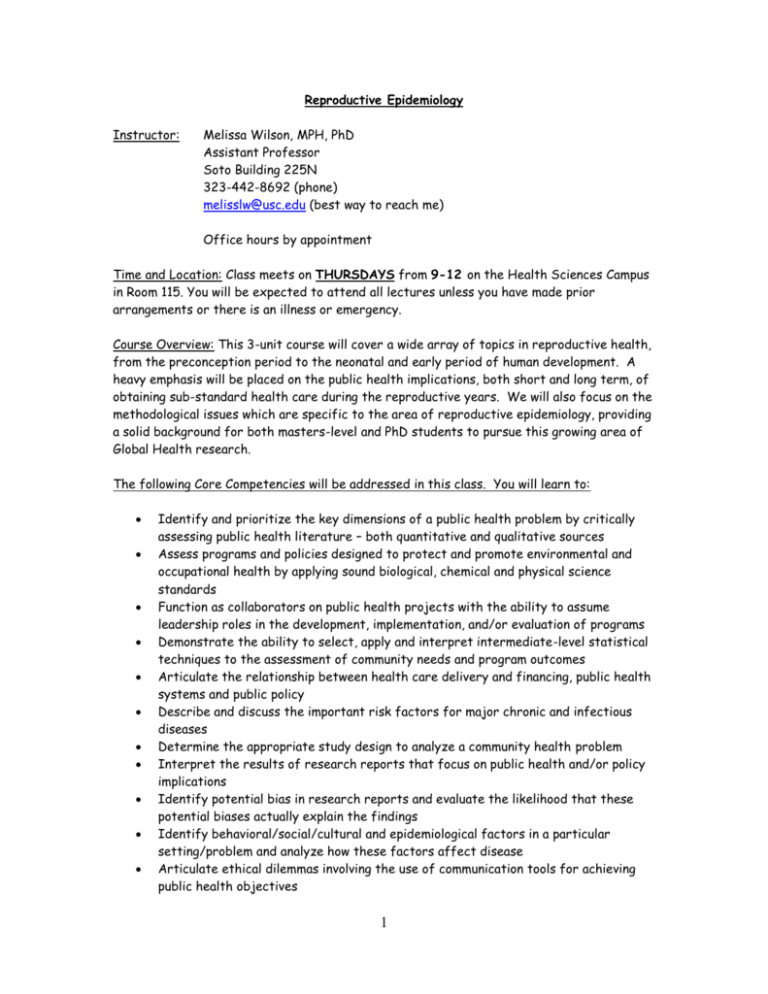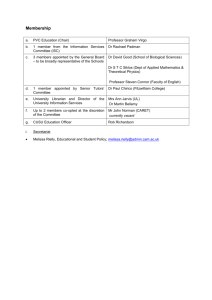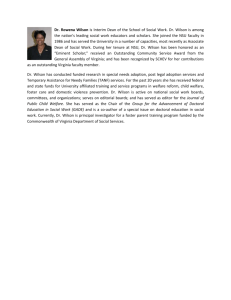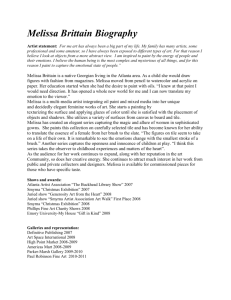Reproductive Epidemiology
advertisement

Reproductive Epidemiology Instructor: Melissa Wilson, MPH, PhD Assistant Professor Soto Building 225N 323-442-8692 (phone) melisslw@usc.edu (best way to reach me) Office hours by appointment Time and Location: Class meets on THURSDAYS from 9-12 on the Health Sciences Campus in Room 115. You will be expected to attend all lectures unless you have made prior arrangements or there is an illness or emergency. Course Overview: This 3-unit course will cover a wide array of topics in reproductive health, from the preconception period to the neonatal and early period of human development. A heavy emphasis will be placed on the public health implications, both short and long term, of obtaining sub-standard health care during the reproductive years. We will also focus on the methodological issues which are specific to the area of reproductive epidemiology, providing a solid background for both masters-level and PhD students to pursue this growing area of Global Health research. The following Core Competencies will be addressed in this class. You will learn to: Identify and prioritize the key dimensions of a public health problem by critically assessing public health literature – both quantitative and qualitative sources Assess programs and policies designed to protect and promote environmental and occupational health by applying sound biological, chemical and physical science standards Function as collaborators on public health projects with the ability to assume leadership roles in the development, implementation, and/or evaluation of programs Demonstrate the ability to select, apply and interpret intermediate-level statistical techniques to the assessment of community needs and program outcomes Articulate the relationship between health care delivery and financing, public health systems and public policy Describe and discuss the important risk factors for major chronic and infectious diseases Determine the appropriate study design to analyze a community health problem Interpret the results of research reports that focus on public health and/or policy implications Identify potential bias in research reports and evaluate the likelihood that these potential biases actually explain the findings Identify behavioral/social/cultural and epidemiological factors in a particular setting/problem and analyze how these factors affect disease Articulate ethical dilemmas involving the use of communication tools for achieving public health objectives 1 Describe the normal patterns of individual and family growth and development from an intergenerational and lifespan perspective Discuss key issues in pediatric health and disease and their implications for public health, including the major domestic and international causes of mortality and morbidity for children and adolescents Incorporate appropriate intervention strategies based on population strengths, needs, values and practices of diverse cultural, racial, ethnic groups into public health interventions for children and families Critically analyze inequities in health status based on age, developmental level, physical ability, race/ethnicity, socioeconomic position and gender Explain the global context in which public health problems occur and the need to respond to the health consequences of international emergencies Articulate the leadership and management skills needed in the 21st century to effectively lead local, national, and global public health systems Apply scientific knowledge and leadership tools and resources to promote health, prevent illness and fight disease around the world Promote the mutual benefits of improving the health status and wellbeing of other countries (Whew!) Grading: The course will consist of weekly 1.5-hour lectures, 1-hour critical original research paper discussions (class participation required) and a 0.5 hour weekly essay quiz which may cover elements of the lecture and/or assigned readings. One brief break will be given between the lecture and critical discussion period of the class. A final project will be assigned (see page 4). 60% 25% 10% 5% Quizzes Project Blackboard Discussions (Article will be provided for discussion, other discussion topics also encouraged) Class Participation (Article will be provided for discussion) 2 Lectures: Guest Lecturers will be invited to cover specific topics, as needed. (order subject to change to accommodate busy MD schedules): Date Speaker Topic Assignment* 8/29/13 Melissa Wilson 1. What is Chapters 1, 2 & Reproductive/Perinatal 8 Epidemiology? 2. Methodology 9/5/13 Melissa Wilson No Class 9/14/13 Melissa Wilson Infant/Maternal Morbidity and Chapters 12 & 18 Mortality Papers TBD 9/19/13 Melissa Wilson Pregnancy Loss Chapters 10 & 11 Saxena et al. Cupul-Uicab et al. 9/26/13 Melissa Wilson Preterm Birth Chapter 14 Kelley et al. 10/3/13 Melissa Wilson Fetal Origins of Adult Disease Chapter 20 Wadhwa et al. Barker Barker & Martyn 10/10/13 Alexandre Bonnin, PhD Placental serotonin: a potential Chapter 20 pathway for the developmental Papers TBD origins of mental disorders 10/17/13 Melissa Wilson Birthweight Chapter 15 Wilcox et al. McDonald et al. 10/24/13 Marc Gualtierri, MD Infertility (male and female) and IVF Chapters 3 & 9 Chapter 2 (review) Articles 10/31/13 Brendan Grubbs, MD, MS Neural Tube Defects: “Effects of Chapter 16 Retinoic Acid on Rat Neural Tube Papers TBD Closure” 11/7/13 Melissa Wilson Preeclampsia: the mother and baby as Chapters 5 & 19 a unit of disease Pages 17-23 (review) Wilson et al. Roberts 11/14/13 Melissa Wilson Research Topics in Pregnancy Chapter 21 Papers TBD 12/5/13 Project Presentations 12/12/13 Project Presentations *Additional papers may be assigned than those listed on the syllabus and/or other papers may be substituted. At least one week’s notice will be given. 3 Prerequisites: PM510 Principles of Biostatistics PM512 Introduction to Epidemiology Textbook: Wilcox, Allen J. Fertility and Pregnancy: An Epidemiologic Perspective Oxford University Press, 2010 Amazon Link, though the bookstore should have the book very shortly!: http://www.amazon.com/Fertility-Pregnancy-Epidemiologic-AllenWilcox/dp/0195342860/ref=ntt_at_ep_dpt_1 STUDENTS WITH DISABILITIES: Check with the MPH office for any special arrangements and policies, and please notify professor or lecturer in a timely fashion regarding any accommodations needed. Students requesting academic accommodations based on a disability need to register with Disability Services and Programs (DSP). A letter of verification for approved accommodations can be obtained from DSP. Please be certain the letter is delivered to the professor/s as early in the semester as possible. DSP is located on the University Park Campus, in STU 301 and is open from 8:30 AM to 5:00 PM, Monday through Friday. The phone number is (213) 740-0776. 4 Final Presention Guidelines The purpose of this presentation is to investigate a condition related to pregnancy, fertility, contraception or basically, any aspect of reproduction or perinatalogy. The information used for your presentation should come from scientific sources. In addition, at least 4 of your sources should have been published in peer-reviewed journals within the last few years. The quality of the journals you select will be considered in the grading of your presentation. Note: Review papers are a good place to start! You may want to tailor your talk to give yourself some creative freedom. You may also use the following outline as a starting point or guide (not necessary to follow this order exactly). 1. 2. 3. 4. 5. 6. 7. 8. 9. Introduction a. Brief background about the natural history of the disease or condition b. Show pictures as needed (e.g., diseased organs). Remember that a picture can speak a thousand words! Descriptive Epidemiology (prefer graphs or tables when possible) a. Demographic statistics b. Patterns/Trends over time c. Discuss any issues related to recording problems or inaccuracies Theoretical causes/pathophysiology a. What is known about the etiology of the disease? b. What is hypothesized about the etiology of the disease? Diagnosis and Treatment a. Diagnosis criteria b. Has diagnosis or treatment changed over time? Risk/Protective Factors Prevention Public Health Impact a. Why is this condition important to study? Other important aspects a. Controversies b. Limitations to the study of this condition – consider biases, study design issues and the possible effects of these limitations, in a general way, on research in this area Bibliographic Slide – at the end of the presentation a. Follow AMA citation style 5 Presentation Requirements & Topics Length: ~30 minutes First Draft Due: October 12, 2011 Final Presentation Dates: November 30 & December 7 (date will be assigned, but volunteers to go first will be considered) Include (Don’t forget!!): Hard copy of your slides (3-6 slides per page) Hard copies of all 4 peer-reviewed journal articles Presentation Tips: Estimate about 1 minute per slide DO NOT simply read from the slide (points will be deducted for this!) Write down the main points that you want to discuss Elaborate on that point during your presentation Engage the audience Ask questions Make frequent eye contact Elaborate on facts with stories, etc. Topics Ideas (depending upon what is covered in lecture): Causes of infertility (pick one!) Cholestasis of Pregnancy Thyroid Disease in pregnancy Breastfeeding (aspects not covered by lecture) HIV and pregnancy Multiple gestation pregnancies Contraception (aspects not covered by lecture) Reproductive global health trends (aspects not covered by lecture) Birth spacing (optimal interval between children) Caesarian section vs. vaginal birth Post-partum depression Mental illness and pregnancy Autoimmune disease and pregnancy And many, many more... **If you have been conducting research or have a particular interest in a disease not listed above, please see the instructor to determine if you might present on that topic. Please have your topic “approved” prior to turning in your outline! **Note: If your topic is very broad and there are too many issues to cover in 30 minutes, you may chose a specific aspect of the topic to cover (e.g., Preterm birth in African American women). 6






![[#OPENDS-1029] Update daily build mail subject to indicate](http://s3.studylib.net/store/data/007734190_2-d66144ca725a9119b45ca78b6568f0a8-300x300.png)



